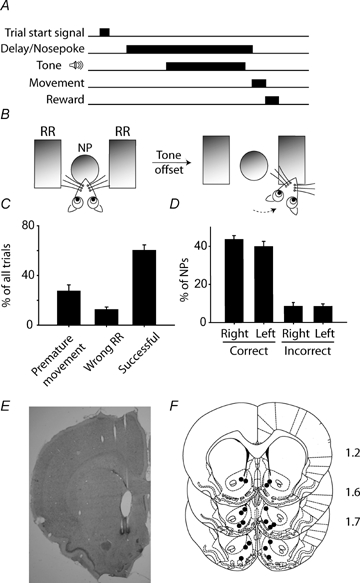Figure 1.

Behavioural paradigm and task performance A and B, a nosepoke (NP) after the start signal initiated the delay period. After a short variable interval, one of two instructive tones was delivered, signalling the required response direction (left or right). Rats were required to maintain the nosepoke until tone offset, which served as a trigger signal for movement to the reward receptacle (RR). Correct trials, in which the nosepoke was maintained for the duration of the tone presentation and the subsequent movement was directed to the instructed reward receptacle, resulted in delivery of a sucrose reward. C, movement prior to tone offset (27 ± 5% of all trials) or movement to the wrong reward receptacle (13 ± 2%) constituted error trials, and sucrose was withheld. In the remaining 60 ± 5% of trials, the NP was maintained until tone offset and movement was made to the correct reward receptacle, resulting in sucrose delivery. D, analysing only trials in which the delay was successfully maintained, there was no direction bias for subsequent movement to the reward receptacle (P > 0.05, comparing percentage correct trials for left versus right, t test). E, a representative section showing electrode placements in the NAcc. F, all recording sites were confined to the nucleus accumbens, spanning the core and shell regions. Anteroposterior distance relative to bregma is shown to the right of each section in millimetres.
